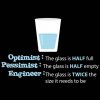Docb
Moderator
- Relationship to Diabetes
- Type 2
Sorry @Amity Island, but for me it was not cynical at all, just a quick appraisal of publicly available information in response to a what was probably a press release. Eddy, and to some extent myself, have done a lot of miles in technical development and have had to be pretty good at sorting the things with potential from the bull pooh. This one has far too many red flags against it.
Fundamentally what we are saying is that we would not invest our pension fund in the company behind it and would recommend that people do not set their sights on a successful outcome from their endeavours. Not cynical but a quick appraisal based on experience.
One or other point of view will be proven wrong in the fulness of time!
Fundamentally what we are saying is that we would not invest our pension fund in the company behind it and would recommend that people do not set their sights on a successful outcome from their endeavours. Not cynical but a quick appraisal based on experience.
One or other point of view will be proven wrong in the fulness of time!

